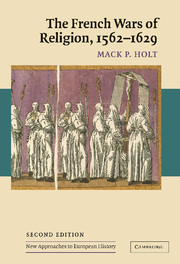Book contents
- Frontmatter
- Contents
- List of maps and figures
- Acknowledgements
- Preface to the Second Edition
- Chronological table of events
- Introduction
- 1 Prologue: Gallicanism and reform in the sixteenth century
- 2 ‘The beginning of a tragedy’: the early wars of religion, 1562–1570
- 3 Popular disorder and religious tensions: the making of a massacre, 1570–1574
- 4 The rhetoric of resistance: the unmaking of the body politic, 1574–1584
- 5 ‘Godly warriors’: the crisis of the League, 1584–1593
- 6 Henry IV and the Edict of Nantes: the remaking of Gallicanism, 1593–1610
- 7 Epilogue: the last war of religion, 1610–1629
- 8 Conclusions: economic impact, social change, and absolutism
- Genealogical charts
- Brief biographies
- Suggestions for further reading
- Index
- NEW APPROACHES TO EUROPEAN HISTORY
Introduction
Published online by Cambridge University Press: 05 June 2012
- Frontmatter
- Contents
- List of maps and figures
- Acknowledgements
- Preface to the Second Edition
- Chronological table of events
- Introduction
- 1 Prologue: Gallicanism and reform in the sixteenth century
- 2 ‘The beginning of a tragedy’: the early wars of religion, 1562–1570
- 3 Popular disorder and religious tensions: the making of a massacre, 1570–1574
- 4 The rhetoric of resistance: the unmaking of the body politic, 1574–1584
- 5 ‘Godly warriors’: the crisis of the League, 1584–1593
- 6 Henry IV and the Edict of Nantes: the remaking of Gallicanism, 1593–1610
- 7 Epilogue: the last war of religion, 1610–1629
- 8 Conclusions: economic impact, social change, and absolutism
- Genealogical charts
- Brief biographies
- Suggestions for further reading
- Index
- NEW APPROACHES TO EUROPEAN HISTORY
Summary
Like Michel de Montaigne, perhaps I too ought to have called this book an essai in the original sense; for an ‘attempt’ is about all one can manage in the face of the confusing morass of court factions, countless leading actors and bit players, a seemingly unending series of peace agreements followed by renewed warfare, and the bizarre diplomatic intrigues of nearly every state in western Europe that made up the French Wars of Religion. It is no small wonder, then, that even specialist historians have never found explaining this conflict a particularly easy task. What is a student to make of the problem? Thus, while this book is certainly a trial or attempt to ‘make the crooked straight and the rough places plain’ for the reader with little background to the French religious wars of the sixteenth and early seventeenth centuries, I hope it is also more than that. Surely any reader who picks up a book claiming to offer ‘new approaches to European history’ has a right to expect as much. So, perhaps it is best to sketch out exactly what is so novel about this approach right at the start.
To begin with, the pages which follow will argue at some length that the series of French civil wars which began with the massacre at Vassy in 1562 and concluded with the Peace of Alais in 1629 was a conflict fought primarily over the issue of religion.
- Type
- Chapter
- Information
- The French Wars of Religion, 1562–1629 , pp. 1 - 6Publisher: Cambridge University PressPrint publication year: 2005
- 1
- Cited by

